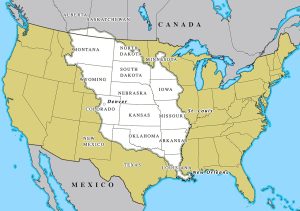WEEK 17
 The Louisiana Purchase was the acquisition of the territory of Louisiana by the United States from the French First Republic in 1803. This consisted of most of the land in the Mississippi River's drainage basin west of the river. In return for fifteen million dollars, or approximately eighteen dollars per square mile, the United States nominally acquired a total of 828,000 sq mi in Middle America. However, France only controlled a small fraction of this area, most of which was inhabited by Native Americans; effectively, for the majority of the area, the United States bought the preemptive right to obtain Indian lands by treaty or by conquest, to the exclusion of other colonial powers. The Kingdom of France had controlled the Louisiana territory from 1682 until it was ceded to Spain in 1762. In 1800, Napoleon, the First Consul of the French Republic, regained ownership of Louisiana in exchange for Tuscany as part of a broader effort to re-establish a French colonial empire in North America. However, France's failure to suppress a revolt in Saint-Domingue, coupled with the prospect of renewed warfare with the United Kingdom, prompted Napoleon to consider selling Louisiana to the United States. Acquisition of Louisiana was a long-term goal of President Thomas Jefferson, who was especially eager to gain control of the crucial Mississippi River port of New Orleans. Jefferson tasked James Monroe and Robert R. Livingston with purchasing New Orleans. Negotiating with French Treasury Minister François Barbé-Marbois, the U.S. representatives quickly agreed to purchase the entire territory of Louisiana after it was offered. Overcoming the opposition of the Federalist Party, Jefferson and Secretary of State James Madison persuaded Congress to ratify and fund the Louisiana Purchase.(Wikipedia)
The Louisiana Purchase was the acquisition of the territory of Louisiana by the United States from the French First Republic in 1803. This consisted of most of the land in the Mississippi River's drainage basin west of the river. In return for fifteen million dollars, or approximately eighteen dollars per square mile, the United States nominally acquired a total of 828,000 sq mi in Middle America. However, France only controlled a small fraction of this area, most of which was inhabited by Native Americans; effectively, for the majority of the area, the United States bought the preemptive right to obtain Indian lands by treaty or by conquest, to the exclusion of other colonial powers. The Kingdom of France had controlled the Louisiana territory from 1682 until it was ceded to Spain in 1762. In 1800, Napoleon, the First Consul of the French Republic, regained ownership of Louisiana in exchange for Tuscany as part of a broader effort to re-establish a French colonial empire in North America. However, France's failure to suppress a revolt in Saint-Domingue, coupled with the prospect of renewed warfare with the United Kingdom, prompted Napoleon to consider selling Louisiana to the United States. Acquisition of Louisiana was a long-term goal of President Thomas Jefferson, who was especially eager to gain control of the crucial Mississippi River port of New Orleans. Jefferson tasked James Monroe and Robert R. Livingston with purchasing New Orleans. Negotiating with French Treasury Minister François Barbé-Marbois, the U.S. representatives quickly agreed to purchase the entire territory of Louisiana after it was offered. Overcoming the opposition of the Federalist Party, Jefferson and Secretary of State James Madison persuaded Congress to ratify and fund the Louisiana Purchase.(Wikipedia)